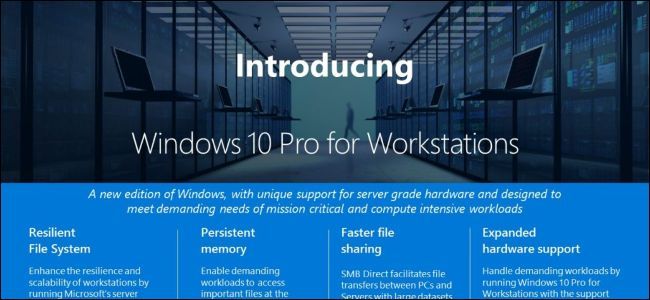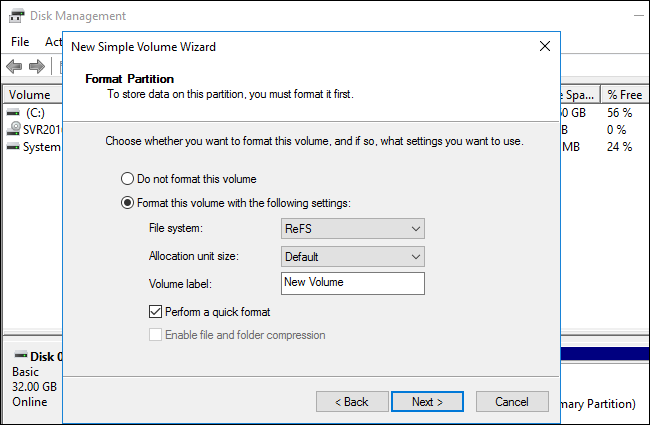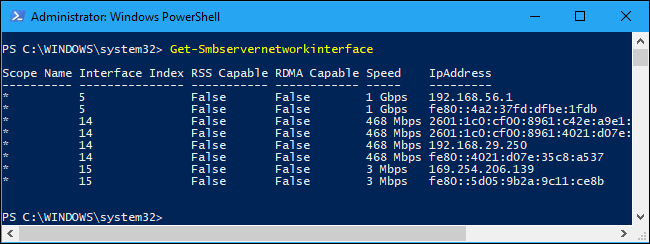Quick Links
Microsoft has announced Windows 10 Pro for Workstations. This is a higher-end version of Windows 10 Professional for expensive PCs with powerful hardware. The included features are already available on Windows Server, but are being brought over to a desktop version of Windows.
Here are the features it includes, and why you would want them.
ReFS (Resilient File System)
Microsoft's new resilient file system, ReFS for short, "provides cloud-grade resiliency for fault-tolerant storage spaces and manages very large volumes with ease."
This feature isn't technically exclusive to Windows 10 Pro for Workstations. You can use it on any edition of Windows 10 along with Storage Spaces. When used along with Storage Spaces, ReFS can detect when data becomes corrupt on a mirrored drive and quickly repair it with data from another drive.
However, ReFS can only be used on Storage Spaces on normal editions of Windows 10. Windows Server 2016 systems can format drives as ReFS without using Storage Spaces, and this offers some performance advantages in certain situations---for example, when using various virtual machine features in Microsoft Hyper-V. But, to really benefit from ReFS, you'll need a PC with multiple storage drives.
At the moment, Windows 10 can't actually boot from ReFS, so there's no way to format your system drive as ReFS. This means ReFS can't fully replace NTFS. It's unclear whether Microsoft is fixing this limitation for Windows 10 Pro for Workstations, or simply allowing users to format any drive with the ReFS file system.
Persistent Memory
Windows 10 Pro for Workstations supports NVDIMM-N hardware. NVDIMM-N is a non-volatile type of memory. This memory is as fast to access and write to as normal RAM, but the data stored in it won't be erased when your computer shoots down---that's what the non-volatile part means.
This allows demanding applications to access important data as quickly as possible. The data doesn't need to be stored on a slower disk and moved back and forth between memory and storage.
The reason we don't all use NVDIMM-N memory today is because it's much more expensive than normal RAM. It's very high-end hardware right now, and if you don't have the expensive hardware, you can't take advantage of this feature anyway.
Faster File Sharing
This edition of Windows 10 includes SMB Direct, a feature also available on Windows Server. SMB Direct requires network adapters that support Remote Direct Memory Access (RDMA).
As Microsoft puts it, "Network adapters that have RDMA can function at full speed with very low latency, while using very little CPU." This aids applications that access large amounts of data on remote SMB (Windows network file sharing) shares over the network. Such applications benefit from faster transfer of large amounts of data, lower latency when accessing data, and low CPU utilization even when transferring a large amount of data very quickly.
Once again, you need high-end hardware that isn't available on a typical consumer desktop PC to do this. If you don't have network adapters that support RDMA, this feature won't help you.
You can check whether your network adapters are RDMA-capable through PowerShell. Right-click the Start button on Windows 10 and select "PowerShell (Admin)" to open PowerShell as Administrator. Type "
Get-SmbServerNetworkInterface
" at the prompt and press Enter. Look under the "RDMA Capable" column to see whether they support RDMA. On a typical desktop PC, they almost certainly won't.
Expanded Hardware Support
Microsoft is allowing Windows 10 Pro for Workstations to run on devices with "high performance configurations", including server-grade Intel Xeon and AMD Opteron processors that would normally require Windows Server.
Windows 10 Pro currently only supports up to two physical CPUs and 2 TB of RAM per system, but Windows 10 Pro for Workstations will support up to four CPUs and 6 TB of RAM.
Once again, this feature will only aid people building expensive, high-end professional PCs.
How Do I Get It?
This new edition of Windows 10 will be available when the Fall Creators Update is released.
Microsoft hasn't actually mentioned a price tag for this product. It's intended for high-end workstation PCs. Microsoft isn't going to sell it alongside other editions of Windows 10 in retail stores, and they have no reason to. All the features only benefit people who require support for expensive, high-end hardware. High-end workstation PCs will ship with Windows 10 Pro for Workstations installed, and it will likely be available to businesses and other organizations in volume license agreements.
While Microsoft is adding another edition of Windows 10, most people won't need to even know it exists. But it's another way for Microsoft to segment the market for Windows licenses, allowing them to charge more for a version of Windows 10 that will be required on very expensive workstation PCs.



